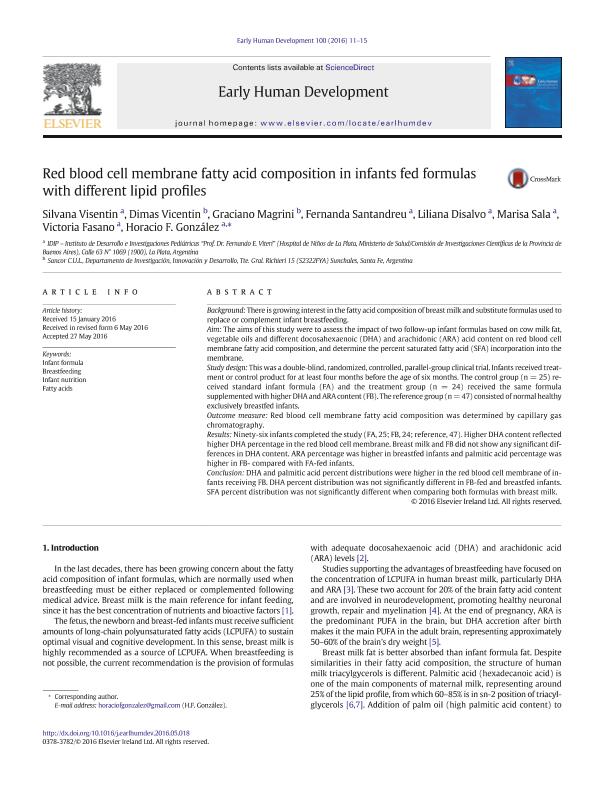Mostrar el registro sencillo del ítem
dc.contributor.author
Visentin, Silvana
dc.contributor.author
Vicentin, Dimas
dc.contributor.author
Magrini, Graciano
dc.contributor.author
Santandreu, Maria Fernanda

dc.contributor.author
Disalvo, Liliana
dc.contributor.author
Sala, Marisa
dc.contributor.author
Fasano, Victoria
dc.contributor.author
Gonzalez, Horacio Federico

dc.date.available
2018-10-04T16:03:20Z
dc.date.issued
2016-09
dc.identifier.citation
Visentin, Silvana; Vicentin, Dimas; Magrini, Graciano; Santandreu, Maria Fernanda; Disalvo, Liliana; et al.; Red blood cell membrane fatty acid composition in infants fed formulas with different lipid profiles; Elsevier Ireland; Early Human Development; 100; 9-2016; 11-15
dc.identifier.issn
0378-3782
dc.identifier.uri
http://hdl.handle.net/11336/61674
dc.description.abstract
Background There is growing interest in the fatty acid composition of breast milk and substitute formulas used to replace or complement infant breastfeeding. Aim The aims of this study were to assess the impact of two follow-up infant formulas based on cow milk fat, vegetable oils and different docosahexaenoic (DHA) and arachidonic (ARA) acid content on red blood cell membrane fatty acid composition, and determine the percent saturated fatty acid (SFA) incorporation into the membrane. Study design This was a double-blind, randomized, controlled, parallel-group clinical trial. Infants received treatment or control product for at least four months before the age of six months. The control group (n = 25) received standard infant formula (FA) and the treatment group (n = 24) received the same formula supplemented with higher DHA and ARA content (FB). The reference group (n = 47) consisted of normal healthy exclusively breastfed infants. Outcome measure Red blood cell membrane fatty acid composition was determined by capillary gas chromatography. Results Ninety-six infants completed the study (FA, 25; FB, 24; reference, 47). Higher DHA content reflected higher DHA percentage in the red blood cell membrane. Breast milk and FB did not show any significant differences in DHA content. ARA percentage was higher in breastfed infants and palmitic acid percentage was higher in FB- compared with FA-fed infants. Conclusion DHA and palmitic acid percent distributions were higher in the red blood cell membrane of infants receiving FB. DHA percent distribution was not significantly different in FB-fed and breastfed infants. SFA percent distribution was not significantly different when comparing both formulas with breast milk.
dc.format
application/pdf
dc.language.iso
eng
dc.publisher
Elsevier Ireland

dc.rights
info:eu-repo/semantics/openAccess
dc.rights.uri
https://creativecommons.org/licenses/by-nc-sa/2.5/ar/
dc.subject
Breastfeeding
dc.subject
Fatty Acids
dc.subject
Infant Formula
dc.subject
Infant Nutrition
dc.subject.classification
Salud Ocupacional

dc.subject.classification
Ciencias de la Salud

dc.subject.classification
CIENCIAS MÉDICAS Y DE LA SALUD

dc.title
Red blood cell membrane fatty acid composition in infants fed formulas with different lipid profiles
dc.type
info:eu-repo/semantics/article
dc.type
info:ar-repo/semantics/artículo
dc.type
info:eu-repo/semantics/publishedVersion
dc.date.updated
2018-10-03T17:45:06Z
dc.journal.volume
100
dc.journal.pagination
11-15
dc.journal.pais
Irlanda

dc.journal.ciudad
Limerick
dc.description.fil
Fil: Visentin, Silvana. Instituto de Desarrollo e Investigaciones Pediátricas “Prof. Dr. Fernando E. Viteri”; Argentina
dc.description.fil
Fil: Vicentin, Dimas. Sancor C.U.L; Argentina
dc.description.fil
Fil: Magrini, Graciano. Sancor C.U.L; Argentina
dc.description.fil
Fil: Santandreu, Maria Fernanda. Consejo Nacional de Investigaciones Científicas y Técnicas; Argentina. Instituto de Desarrollo e Investigaciones Pediátricas “Prof. Dr. Fernando E. Viteri”; Argentina
dc.description.fil
Fil: Disalvo, Liliana. Instituto de Desarrollo e Investigaciones Pediátricas “Prof. Dr. Fernando E. Viteri”; Argentina
dc.description.fil
Fil: Sala, Marisa. Instituto de Desarrollo e Investigaciones Pediátricas “Prof. Dr. Fernando E. Viteri”; Argentina
dc.description.fil
Fil: Fasano, Victoria. Instituto de Desarrollo e Investigaciones Pediátricas “Prof. Dr. Fernando E. Viteri”; Argentina
dc.description.fil
Fil: Gonzalez, Horacio Federico. Instituto de Desarrollo e Investigaciones Pediátricas “Prof. Dr. Fernando E. Viteri”; Argentina
dc.journal.title
Early Human Development

dc.relation.alternativeid
info:eu-repo/semantics/altIdentifier/doi/https://dx.doi.org/10.1016/j.earlhumdev.2016.05.018
dc.relation.alternativeid
info:eu-repo/semantics/altIdentifier/url/https://www.sciencedirect.com/science/article/pii/S0378378216300135
Archivos asociados
